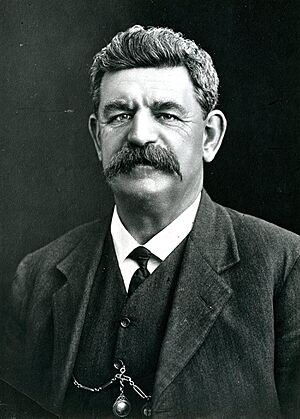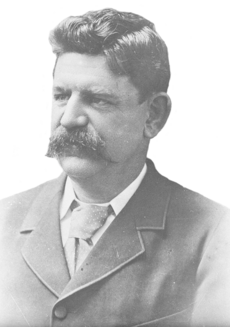James McGowen facts for kids
Quick facts for kids
James McGowen
|
|
|---|---|

McGowen in 1913
|
|
| 18th Premier of New South Wales | |
| In office 21 October 1910 – 29 June 1913 |
|
| Monarch | George V |
| Governor | Lord Chelmsford Sir Gerald Strickland |
| Preceded by | Charles Wade |
| Succeeded by | William Holman |
| Member of the New South Wales Legislative Assembly for Redfern |
|
| In office 17 June 1891 – 21 February 1917 |
|
| Preceded by | William Stephen |
| Succeeded by | William McKell |
| Member of the New South Wales Legislative Council | |
| In office 17 July 1917 – 7 April 1922 |
|
| Personal details | |
| Born |
James Sinclair Taylor McGowen
16 August 1855 at sea |
| Died | 7 April 1922 (aged 66) Petersham, New South Wales, Australia |
| Spouse |
Emily Towner
(m. 1878) |
| Occupation | Boilermaker |
James Sinclair Taylor McGowen (born August 16, 1855 – died April 7, 1922) was an important Australian politician. He made history as the first person from the Australian Labor Party (ALP) to become the Premier of New South Wales. He held this top job from 1910 to 1913.
McGowen was born at sea while his English parents were traveling to Australia. He trained as a boilermaker, which is someone who builds and repairs boilers. He quickly became involved in the Australian labour movement, which worked to improve conditions for workers. In 1888, he became the president of the Sydney Trades Hall, an important center for workers' unions.
He was first elected to the New South Wales Legislative Assembly in 1891. This was a big step for the Labor Party. He became the party's leader in 1894. After Australia became a federation in 1901, he continued to lead the party. In 1904, he became the leader of the opposition. His party won a majority government in 1910, and he became Premier. As Premier, McGowen introduced many new and helpful changes. He was later replaced by his deputy, William Holman, in 1913.
Early Life and Family
James McGowen was born on a ship called the "Western Bride." His parents, James McGowen and Eliza Ditchfield, were from England. His father was also a boilermaker. He worked on building bridges, first in Victoria and then in New South Wales.
James McGowen had limited schooling. In 1870, he started an apprenticeship to become a boilermaker. An apprenticeship is like on-the-job training. He joined the United Society of Boilermakers and Iron Shipbuilders of New South Wales in 1873. The next year, he became its secretary. He later worked for the railway department. In 1888, he was chosen to be president of the Trades Hall committee. He worked hard to raise money to build the Sydney Trades Hall.
In 1878, McGowen married Emily Towner in Redfern, Sydney.
Political Journey
In 1891, the Labor Council of New South Wales created the Labor Electoral League. This group later became the Labor Party. McGowen ran for election in the area of Redfern. He was one of 35 Labor candidates who won. He was also the most experienced union member among them. He kept his seat in parliament until 1917.
The first Labor politicians in New South Wales often disagreed with each other. McGowen was one of only three who promised to follow party rules. He became the Labor Party's leader in parliament in 1894. This was because he was good at public speaking and had more experience.
The government at the time, led by George Reid, needed Labor's support to pass laws. With Labor's help, they lowered taxes on imported goods and introduced income tax. They also made it easier to become a member of the Legislative Council. McGowen led Labor in opposing the first plan for Australia's Federation. His party thought the plan was not democratic enough. However, once the plan was approved by voters in 1899, Labor accepted the new Constitution. In 1901, McGowen tried to win a seat in the new federal parliament but lost by a small number of votes.
In 1907, McGowen and the Labor Party wanted the government to take over the iron and steel industry. They made a change to a law that accidentally caused a company called William Sandford Limited to fail. This company owned the Lithgow Blast Furnace in Lithgow.
Becoming Premier
People trusted James McGowen because he was honest and fair. These qualities helped the Labor Party win the 1910 election. He was Premier until 1913. He let his deputy, William Holman, handle most of the party's daily tasks. Besides being Premier, he was also the state's Treasurer for part of 1911. He was also the Chief Secretary from December 1911.
In 1913, while Holman was away, McGowen tried to end a strike by gas workers. He threatened to fire them and hire new workers. This made many in the Labor Party angry. When Holman returned, he arranged for McGowen to be replaced. McGowen then became the Minister for Labour and Industry in Holman's new government. He held this job until January 1914.
The government led by McGowen worked to support hospitals and clinics. Their goal was to create a universal health care system, where everyone could get medical help. Doctors did not like the idea of the government controlling healthcare. So, the government focused on funding new and existing medical places. They also supported nursing services for people in remote areas. Groups called Friendly Societies also received money to help people get affordable medical care. This helped improve medical services across New South Wales.
His government also expanded public works, like building roads and bridges. They made important changes to education. They also reformed laws about elections, income tax, and housing for workers. The Theatres and Public Halls Act 1912 introduced rules for censoring films. This included a ban on films about bushrangers, which were seen as encouraging crime.
Later Years
Three of McGowen's sons fought in World War I. Sadly, one of them was killed in 1915 at the Battle of Gallipoli. McGowen strongly supported Australia's involvement in the war.
In 1916, the Labor Party decided to oppose conscription. Conscription meant forcing people to join the army. McGowen believed in conscription. Because of this, he and many other Labor politicians were removed from the party.
In the 1917 election, McGowen lost his seat to William McKell, who later became Premier himself. However, McGowen's political career was not over. His old rival, Holman, who had also left the Labor Party, appointed McGowen to the New South Wales Legislative Council in July 1917. At that time, members of this council were not elected by the public.
James McGowen passed away from heart disease in Petersham, New South Wales, a suburb of Sydney. He was survived by his wife, five of their seven sons, and two daughters. Many people attended his funeral at St Paul's Church in Redfern, New South Wales on April 8, 1922. He was buried at Rookwood Cemetery.
Images for kids




